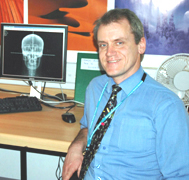Download this article as PDF
Addenbrooke’s Oncology Centre, Cambridge University Hospitals NHS Foundation Trust, recently took delivery of a Pukka-j Oncology Image Store and online disaster recovery solution. The Pukka-j Oncology Store forms a single central repository, including an online data backup with dedicated workspace for managing, storing and accessing all oncology-related images.
Pukka-j specialises in Healthcare IT and is committed to DICOM, HL7 and IHE industry standards. The Pukka-j Oncology Store is designed as an open system that allows users to retain their choice of equipment supplier.
As a 1,000 bed teaching hospital, Addenbrooke’s is one of the Government’s new biomedical research centres with a world-class research reputation. It supplies acute and specialist services for the local as well as regional population, with the Oncology Centre providing a service to more than 4,000 new patients each year, from East Anglia and beyond. It offers a highly integrated approach to the management of both common and rare cancers, with specialist facilities that include a computerised treatment planning system for use in radiotherapy, which was recently updated to include full 3-D facilities for conformal therapy. This will soon be linked to the computerised radiotherapy equipment to allow high accuracy of verification and recording of radiotherapy (RT) treatment.
Pukka-j has an established track record in the handling of radiotherapy images, and the provision of simple and elegant solutions for this complex area. Its rule-based software facilitates an automated workflow between the modalities and workstations within the Oncology department, being able to handle all RT images, as well as allowing for the intercommunication between multiple-vendor systems.
The Pukka-j system is based on DICOM RT, an extension of DICOM, the industry-wide norm for PACS. DICOM RT has been developed specifically for handling radiotherapy modalities and as such is the standard for integrating the specific imaging systems and modalities employed within RT departments. It includes the provision of the specifications for transferring medical images and related information, while emphasising cross-vendor connectivity through the use of standardised protocols. Developed to suit the particular needs of radiotherapists, DICOM RT includes in its scope RT Image for all normal RT imaging (including simulator images and portal images); RT Plan, which contains the geometric and dosimetric data for courses of external beam treatment or brachytherapy; RT Structure Set, which includes patient-related structures identified from diagnostic data; RT Dose for dose distributions from the planning system and dose matrix, and RT Treatment Record, which records all data from the treatment summary.
The hospital is enthusiastic about the new facility. Andrew Hoole, of the Medical Physics and Clinical Engineering Department at Addenbrooke’s comments:
Pukka-j impressed staff at the hospital, not only when the company presented their initial plans, but also when the working relationship developed. Pukka-j’s ability to work with us in developing a system that is tailored to suit the needs of the Radiotherapy Department, including their response to feedback and actions to help develop the solution reinforced our first impressions. The installation itself went remarkably easily. All of the different modalities in the centre were quickly configured to utilise the server as a central store. We are looking forward to exploiting the additional features of the system to streamline our process.
The online disaster recovery solution that was also provided by Pukka-j will give the Centre a resilient back-up system, using the company’s unique DICOM mirror software. Data is automatically backed-up so that should a failure occur, the mirrored DICOM Server prevents loss of data and workflow.
The Oncology Centre itself serves the western districts of the Eastern Regional Health Authority with the Regional Cancer Centre at Cambridge being linked with cancer units at several hospitals in the region, where many of the Oncology Centre’s consultants and other staff run sessions.
Within the Radiotherapy Department at the Centre a full range of equipment is offered for the treatment of cancer, including five linear accelerators, a dedicated CTR scanner, an orthovoltage unit and two simulators. A full brachytherapy service for sealed and unsealed source treatments, including a medium dose rate selectron for gynaecological treatment and an iodine suite for thyroid conditions is also available. In addition, Radiotherapy Physics, part of the Medical Physics and Clinical Engineering Department at the Hospital, provide the physics support to the Oncology Centre. As well as measurement and calibration to ensure the delivery of accurate doses of radiation within National protocols, they cover a number of specialised areas, such as the production of computerised treatment plans for individual patients

